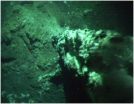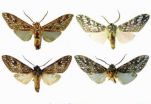(Press-News.org) Have you ever wondered why, and how, shoals of fish are comprised of fish of the same size? According to new research by Ashley Ward, from the University of Sydney in Australia, and Suzanne Currie, from Mount Allison University in Canada, fish can use a variety of different sensory cues to locate shoal-mates, but they are able to use chemical cues to find other fish of the same size as themselves. Using these cues, they can form a group with strength in numbers. The work is published online in Springer's journal, Behavioral Ecology and Sociobiology.
Forming groups is beneficial for animals. One important benefit is the reduction of individual risk from predators. Indeed when animals are in groups, predators are confronted by a number of almost identical prey animals, making it more challenging to select a target.
Dr. Ward said, "Fish typically form shoals with fish of the same size. The key question that motivated our study is this: How on earth does a fish know how big it is? For humans this is trivial - we can stand on a flat surface and see whether we're taller or shorter than someone, or we can look in a mirror. These options don't exist for fish, so how do they choose to associate with fish of the same size?"
The scientists explored which of their senses fish use both to assess the size of other individuals, and to determine how big they are themselves. They studied two freshwater shoaling fish species: three-spined stickleback and banded killfish. In a series of experiments, they exposed the fish to a variety of chemical cues - either from fish of the same species of varying sizes or a control, so-called 'blank' cue. Chemical cues are formed as fish constantly emit molecules into their surroundings.
Ward continued, "We know the sense of smell is well developed in fish and that they are sensitive to tiny differences in the chemical signature given off by others. So could they smell how big they are themselves and use this as a template to assess the size of others? It seems they can."
Both species of shoaling fish preferred the chemical cues of same-sized fish than those of larger or smaller fish from their own species. This suggests that the fish were able to determine their own size relative to other fish of the same species, primarily through chemical self-referencing.
"Using chemical cues to locate similarly sized fish of the same species in the wild promotes the formation of shoals, which creates confusion for predators as well as more coordinated, and potentially efficient, patterns of behavior for both activity and nutrition," concluded Ward.
###
Reference
Ward A & Currie S (2013). Shoaling fish can size-assort by chemical cues alone. Behavioral Ecology and Sociobiology; DOI 10.1007/s00265-013-1486-9
The full-text article is available to journalists on request. END
Nothing fishy about swimming with same-sized mates
Same-sized fish stick together, using chemical cues to identify each other
2013-02-06
ELSE PRESS RELEASES FROM THIS DATE:
Biocontrol research on Brazilian peppertree in Florida discovers new cryptic species
2013-02-06
Dr Michael Pogue, a Research Entomologist in the ARS Systematic Entomology Laboratory, at the Smithsonian Institution, Washington, DC, was sent a series of moth specimens from Bahia, Brazil, for identification. The insects were under consideration as a possible biocontrol agent for the invasive Brazilian peppertree in Florida.
'The species was initially identified as a common species, but when comparisons were made, it became evident that there were multiple species involved' said Dr. Pogue. Using characters from the moths' male and female genitalia, Dr. Pogue determined ...
Widely used nanoparticles enter soybean plants from farm soil
2013-02-06
Two of the most widely used nanoparticles (NPs) accumulate in soybeans — second only to corn as a key food crop in the United States — in ways previously shown to have the potential to adversely affect the crop yields and nutritional quality, a new study has found. It appears in the journal ACS Nano.
Jorge L. Gardea-Torresdey and colleagues cite rapid increases in commercial and industrial uses of NPs, the building blocks of a nanotechnology industry projected to put $1 trillion worth of products on the market by 2015. Zinc oxide and cerium dioxide are among today's most ...
Study of a rare disease making people look like a woman but having male genitals under study
2013-02-06
University of Granada researchers have designed a guideline for physicians and patients on the Androgen Insensitivity Syndrome (AIS), a rare disease that makes the subject develop reverse sex, which occurs when a subject looks like a woman but has male genes.
AIS has low prevalence (it only affects one in 2000 people), and it is characterized by the inability of tissues to respond to the action of male hormones. This prevents individuals with XY sex hormones (i.e. 46,XY) to develop male genitalia. This disorder is caused by a mutation in the gene that codifies the receptor ...
Being overweight linked to higher risk of gum disease
2013-02-06
CHICAGO (Feb. 6, 2013)—Impacting approximately one-third of the U.S. population, obesity is a significant health concern for Americans. It's a risk factor for developing type 2 diabetes, heart disease, and certain forms of cancer, and now, according to an article published in the January/February 2013 issue of General Dentistry, the peer-reviewed clinical journal of the Academy of General Dentistry (AGD), it also may be a risk factor for gum disease.
"We know that being overweight can affect many aspects of a person's health," says Charlene Krejci, DDS, MSD, lead author ...
The European Space Sciences Committee reacts
2013-02-06
European Science Foundation's ESSC comments the decisions taken (or not) at ESA's council meeting at ministerial level.
Strasbourg – 6, February, 2013 - The European Space Sciences Committee (ESSC) today released its position on the perspectives for the European Space Agency's (ESA) scientific programmes. The position statement provides recommendations on the outcomes of the ESA council meeting at ministerial level, which took place on 26-27 November 2012 in Naples.
The statement comments on the impact for science-relevant ESA's programmes resulting from the decisions ...
Learning from the linker
2013-02-06
Mature cells can be reprogrammed to pluripotency and thus regain the ability to divide and differentiate into specialized cell types. Although these so-called induced pluripotent stem cells (iPS cells) represent a milestone in stem cell research, many of the biochemical processes that underlie reprogramming are still not understood. Scientists from the EMBL Hamburg and from the Max Planck Institute for Molecular Biomedicine in Münster, Germany now shed new light on this process. In a study published today in Nature Cell Biology, the scientists describe important details ...
Shimmering water reveals cold volcanic vent in Antarctic waters
2013-02-06
The location of an underwater volcanic vent, marked by a low-lying plume of shimmering water, has been revealed by scientists at the National Oceanography Centre, Southampton.
Writing in the journal PLOS ONE the researchers describe how the vent, discovered in a remote region of the Southern Ocean, differs from what we have come to recognise as "classic" hydrothermal vents. Using SHRIMP, the National Oceanography Centre's high resolution deep-towed camera platform, scientists imaged the seafloor at Hook Ridge, more than 1,000 metres deep.
The study, funded by the ...
Targets of bully bosses aren't the only victims, new UNH research shows
2013-02-06
DURHAM, N.H. – Abusive bosses who target employees with ridicule, public criticism, and the silent treatment not only have a detrimental effect on the employees they bully, but they negatively impact the work environment for the co-workers of those employees who suffer from "second-hand" or vicarious abusive supervision, according to new research from the University of New Hampshire.
In the first ever study to investigate vicarious supervisory abuse, Paul Harvey, associate professor of organizational behavior at UNH, and his research colleagues Kenneth Harris and Raina ...
ZooKeys opens the gates to America's moth diversity
2013-02-06
Since its inception in 2009, the "Contributions to the systematics of New World macro-
moths" series in ZooKeys has been playing an important role in publishing taxonomic changes and new discoveries concerning moth diversity in North America. With a total of 49 publications by 38 authors, this well-established series is among the topic leaders, alongside publications such as Canadian Staphylinidae.
Geographic coverage in Zookeys has previously focused primarily on the North American fauna (Canada, United States and Mexico). This issue marks a rapid acceleration in contributions ...
Study identifies skiers who can be successfully treated without surgery after an ACL tear
2013-02-06
Roughly a quarter of recreational skiers who tear their anterior cruciate ligament (ACL) while hitting the slopes can be successfully treated without surgery, according to a new study. The study, conducted by researchers at Hospital for Special Surgery in New York City, appears online ahead of print in the journal Knee Surgery Sports Traumatology Arthroscopy.
"Some patients who tear their ACL while skiing can get away without surgery. Their ligament heals by itself, they will have stable knees, and they will be able to do whatever they want, including skiing," said Robert ...
LAST 30 PRESS RELEASES:
Anxiety and insomnia may lower natural killer cell count, potentially repressing immune function
How parasitic, asexual plants evolve and live
Research spotlight: A subset of patients with depression could benefit from anti-inflammatory treatment
New fully digital design paves the way for scalable probabilistic computing
Membrane electrode assembly design for high-efficiency anion exchange membrane water electrolysis
U.S. debt ceiling disputes show measurable impact on global crude oil markets
Climate extremes triggered rare coral disease and mass mortality on the Great Barrier Reef
Direct observation reveals “two-in-one” roles of plasma turbulence
Humans rank between meerkats and beavers in monogamy ‘league table’
US fossil reveals early mass-burial event and ancient microbial attack
Sedative choice could improve outcomes for breathing tube patients
New superconducting thin film for quantum computer chips
Simulations reveal protein "dynamin" constricts cell membranes by loosening its grip
Nearly 1 in 5 UK emergency department patients cared for in corridors/waiting rooms
Heavy energy drink intake may pose serious stroke risk, doctors warn
Violence against women and children among top health threats: New global study reveals disease burden far larger than previously estimated
Predicting who is at risk of developing type 1 diabetes, as new drugs now available
New gene-mapping method unlocks hidden drivers of cancer
Ocean current and seabed shape influence warm water circulation under ice shelves
Call to increase funding for ‘invisible’ Deaf victim-survivors of domestic abuse
University of Maryland School of Medicine names distinguished scientist and academic leader Gerald M. Wilson, PhD, as Chair of the Department of Biochemistry and Molecular Biology
Receptors in mammary glands make livestock and humans inviting hosts for avian flu
Icy hot plasmas
Treating adults with autism: Maryland Clinical Center offers national blueprint for care after pediatric transition
University of Phoenix College of Doctoral Studies releases white paper on reclaiming control to build workforce resilience
NCCN Summit seeks to improve care for veterans and first responders with cancer from line-of-duty exposure
ERC Consolidator Grant for soft robotics researcher
Dual-action arts and wellbeing program transforms dementia care
The global plastic waste trade contributes to coastal litter in importing countries, study shows
UT Dallas partners with Tech Mahindra on AI innovation
[Press-News.org] Nothing fishy about swimming with same-sized matesSame-sized fish stick together, using chemical cues to identify each other


